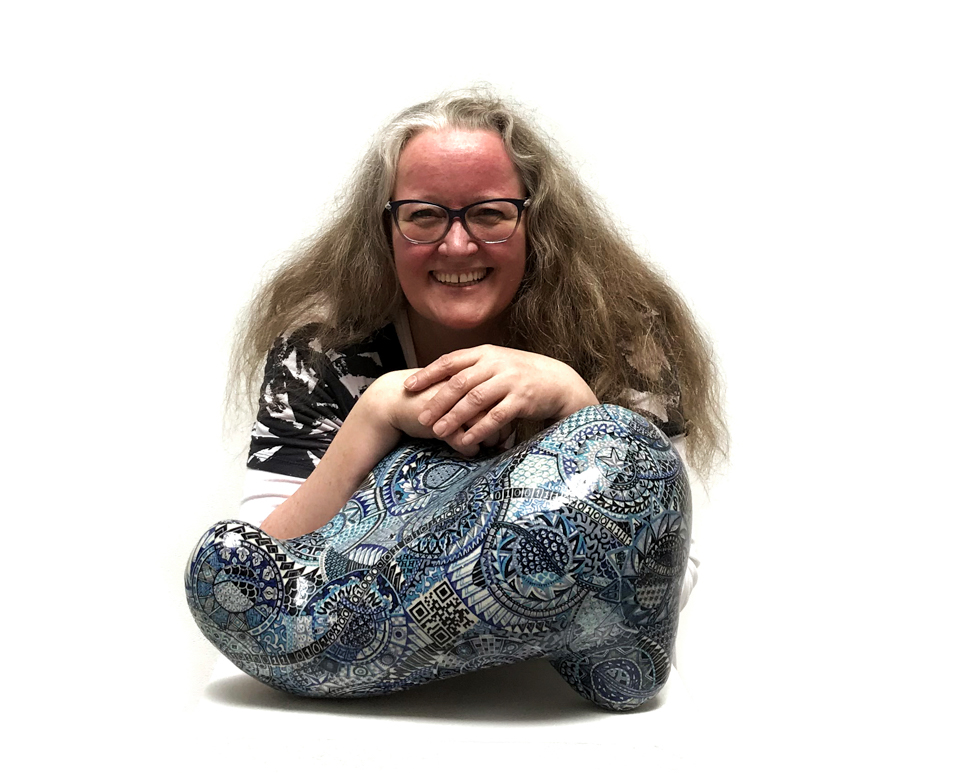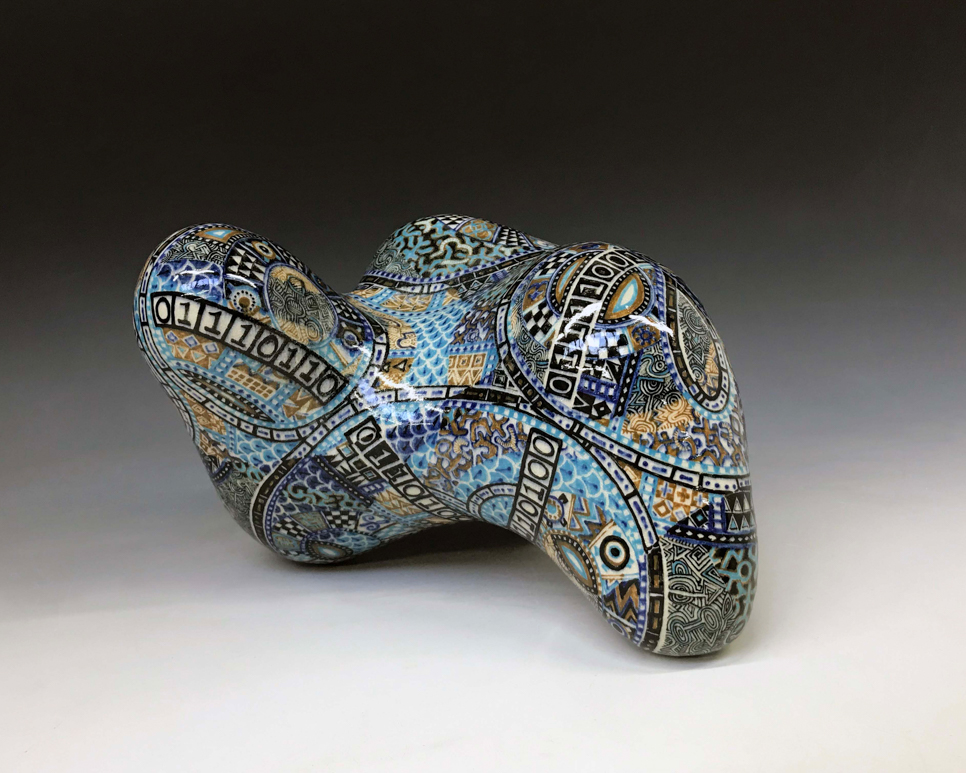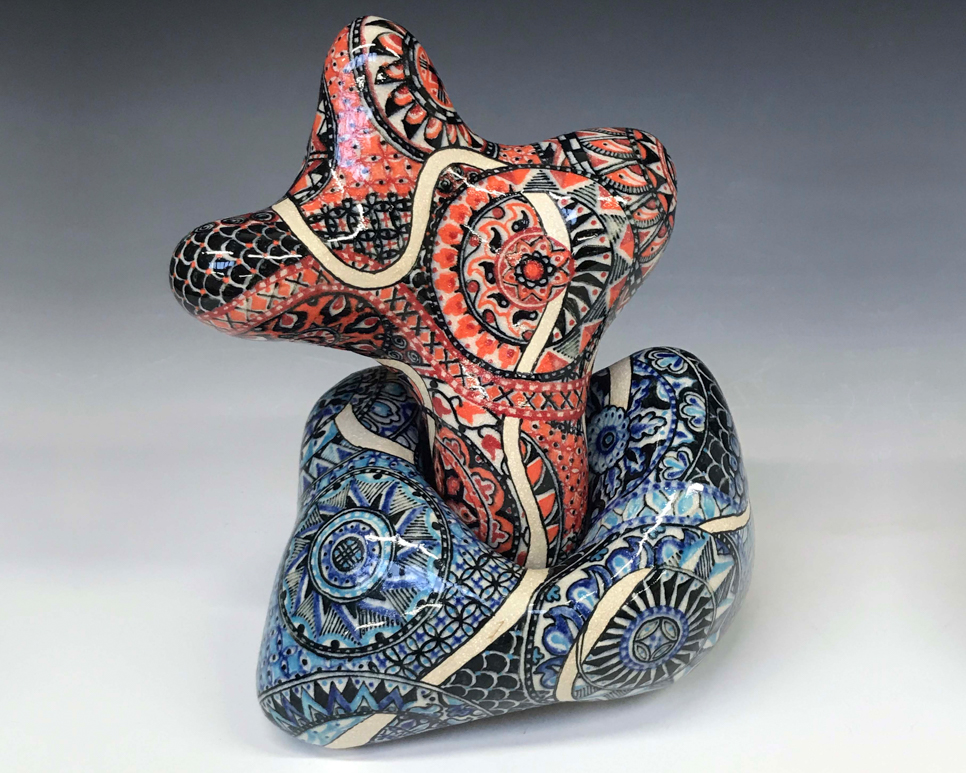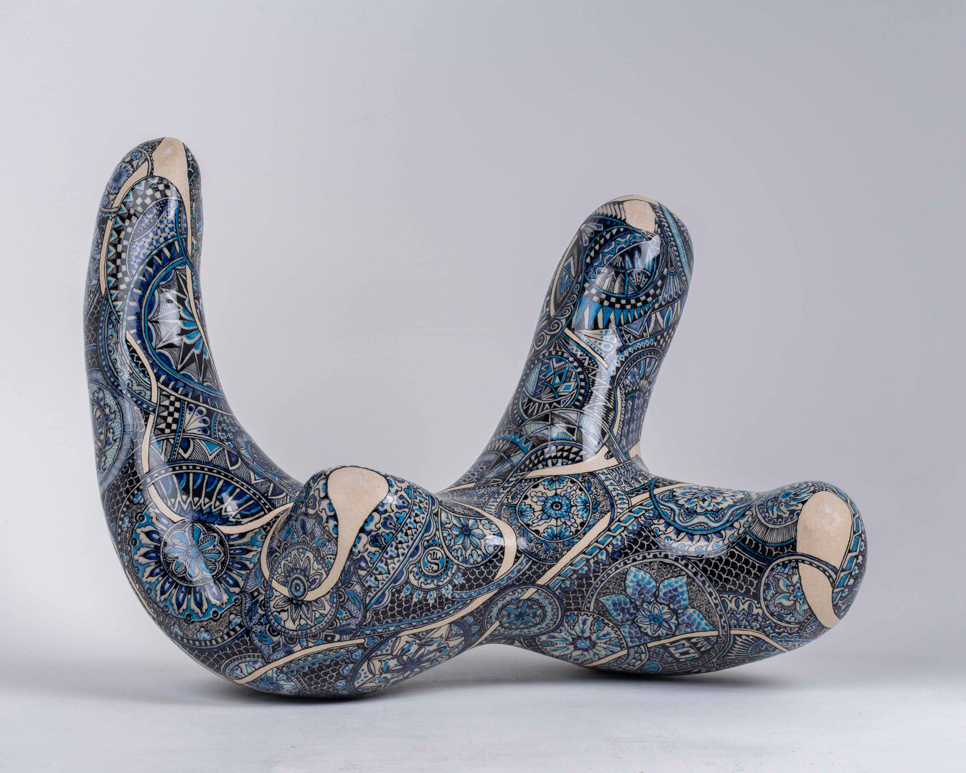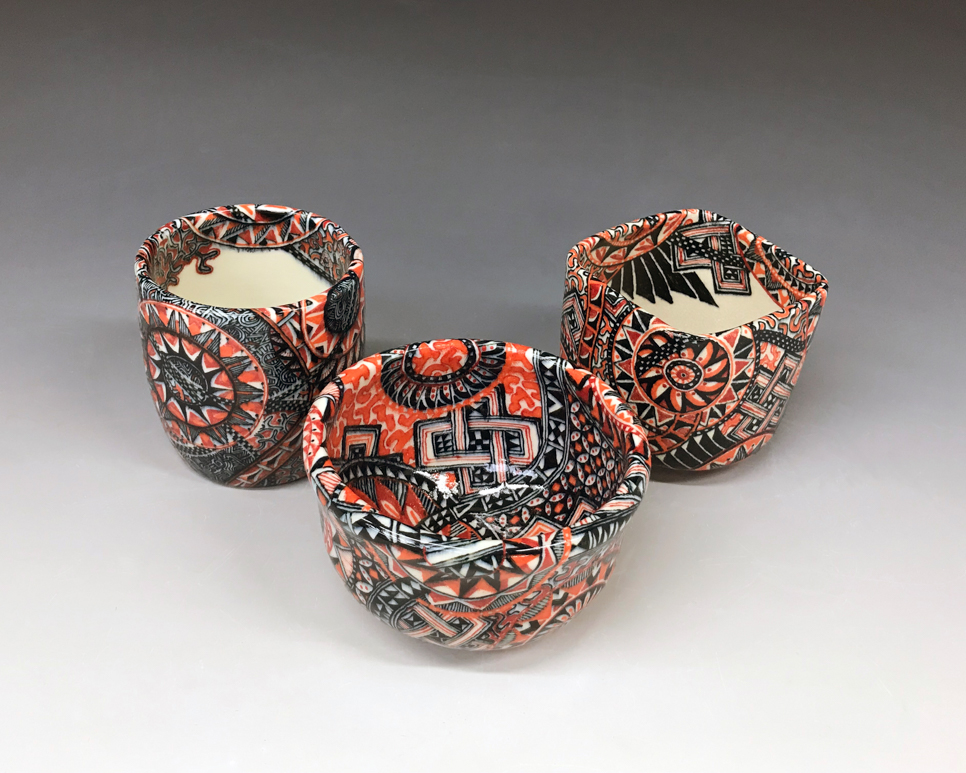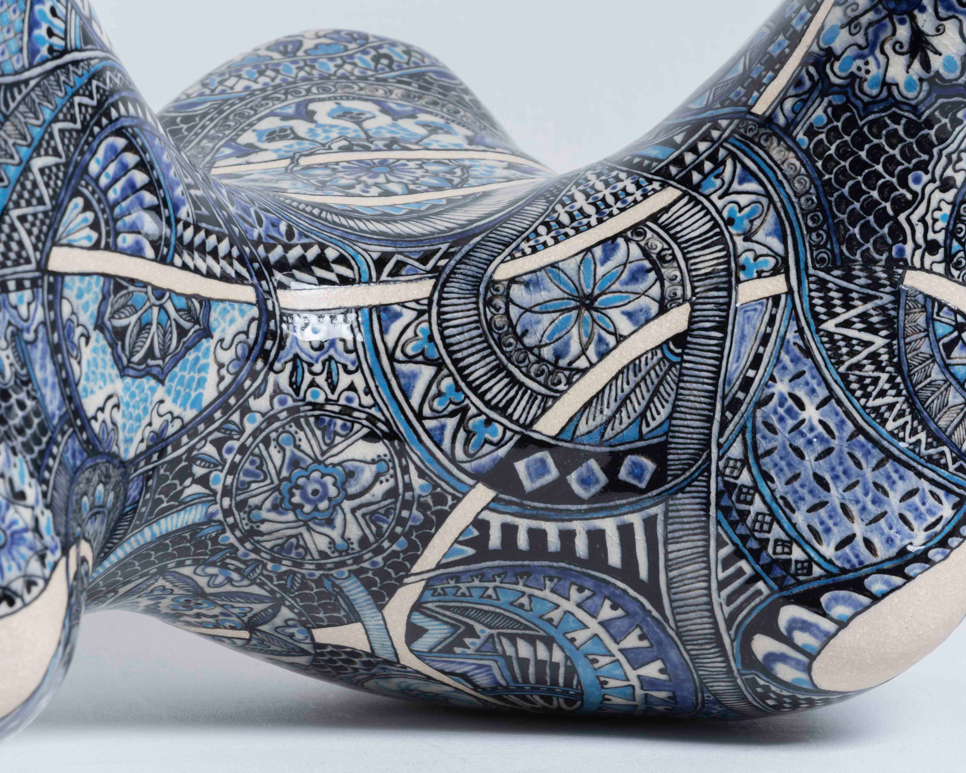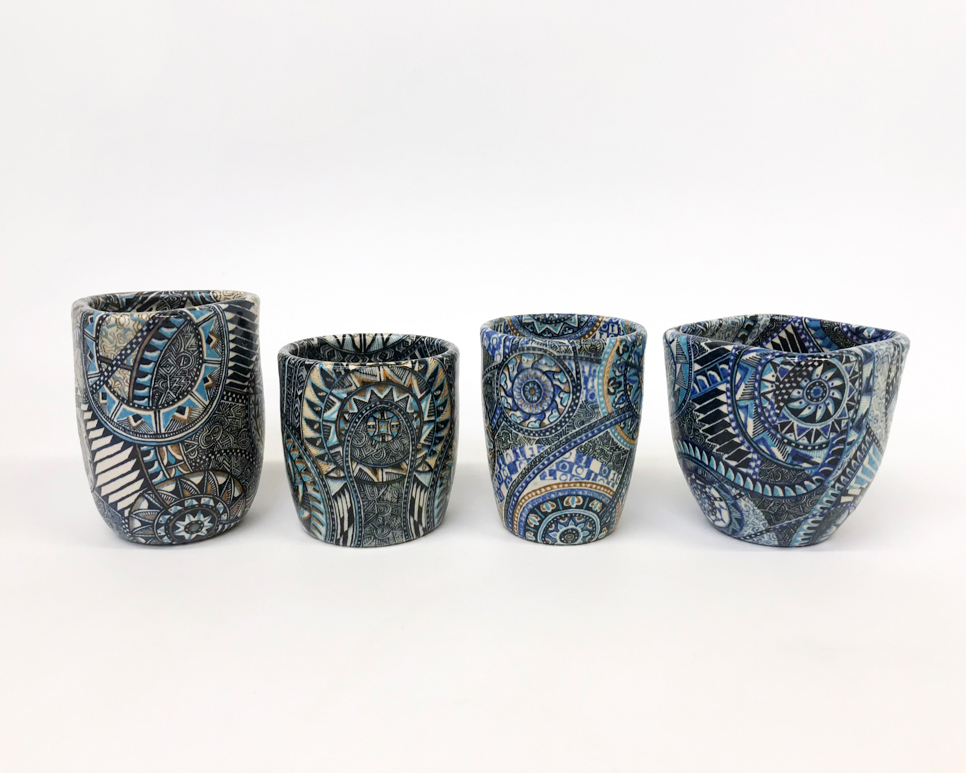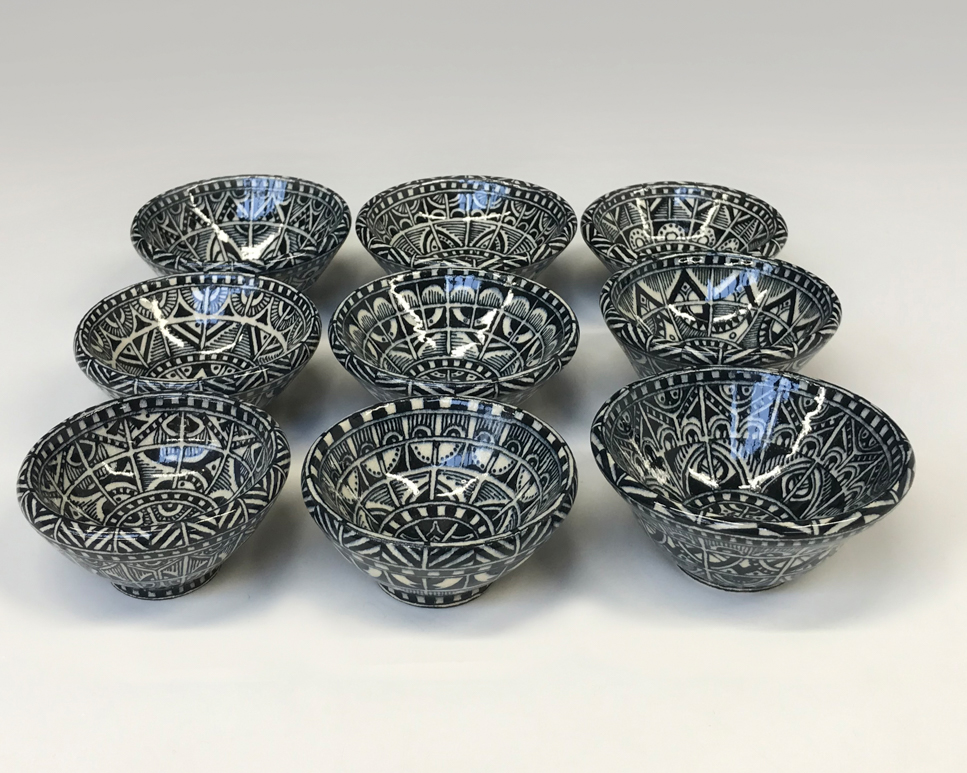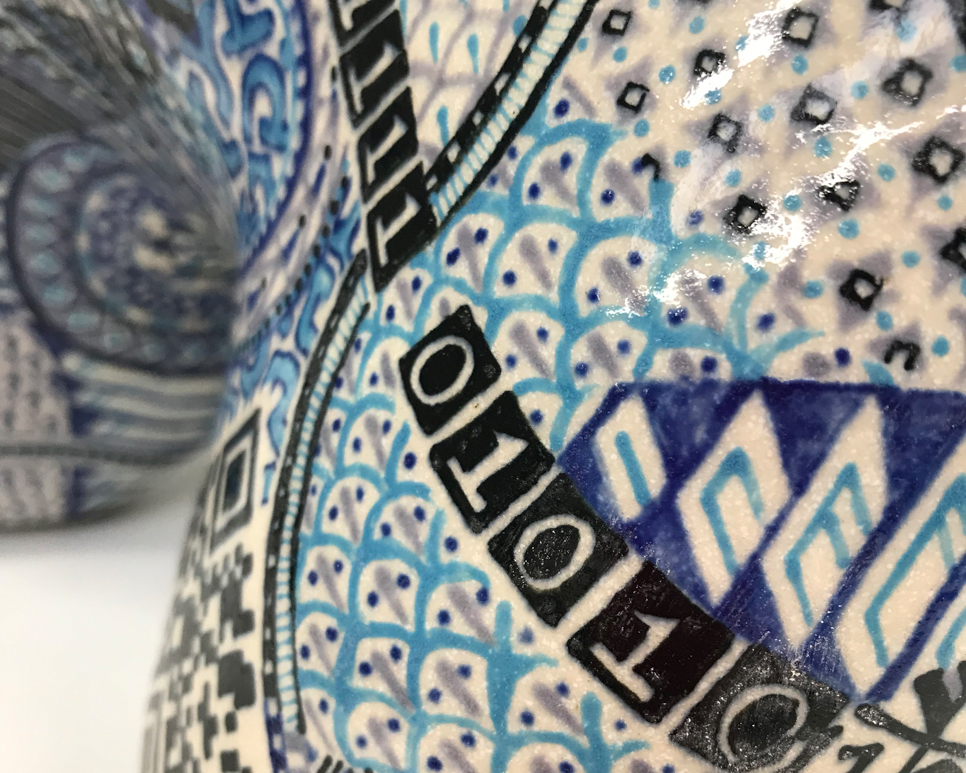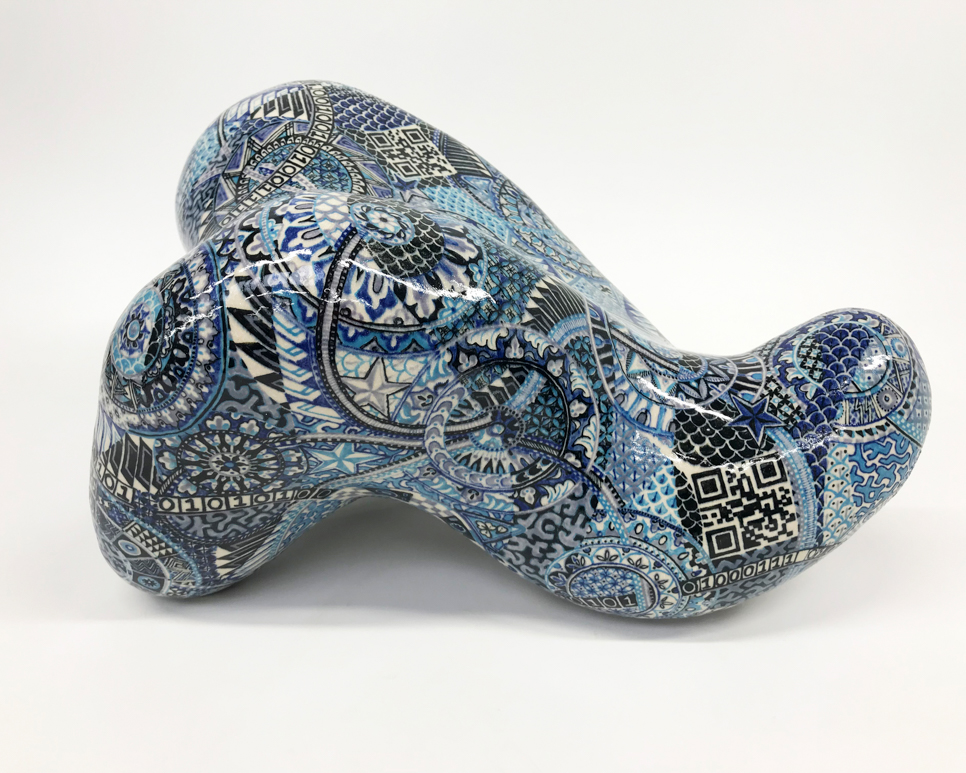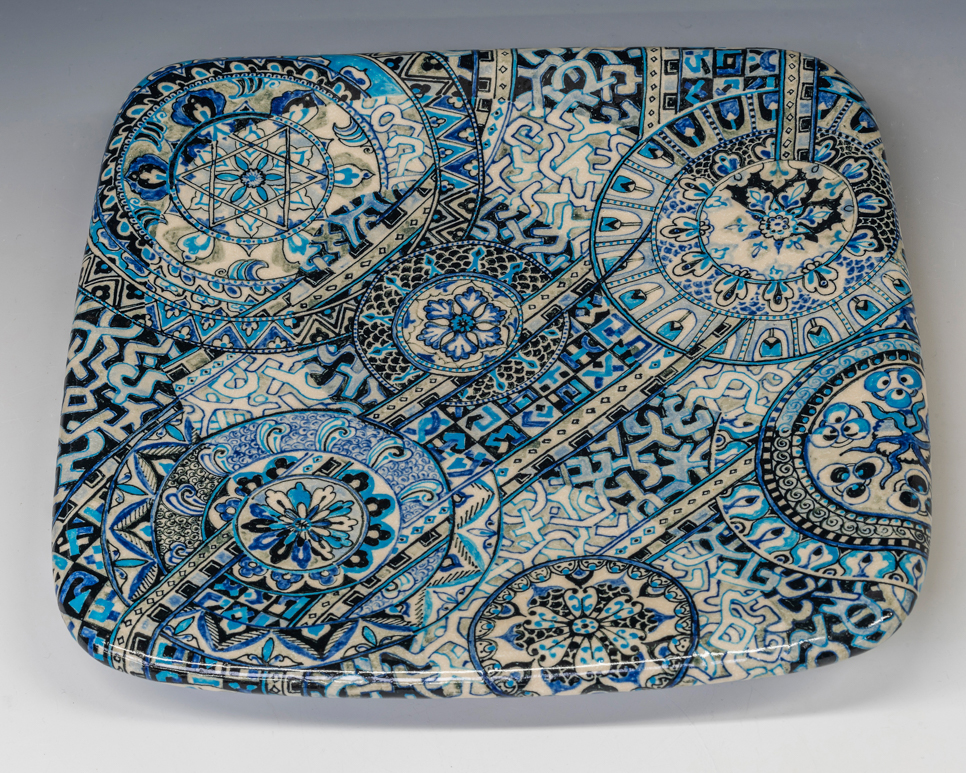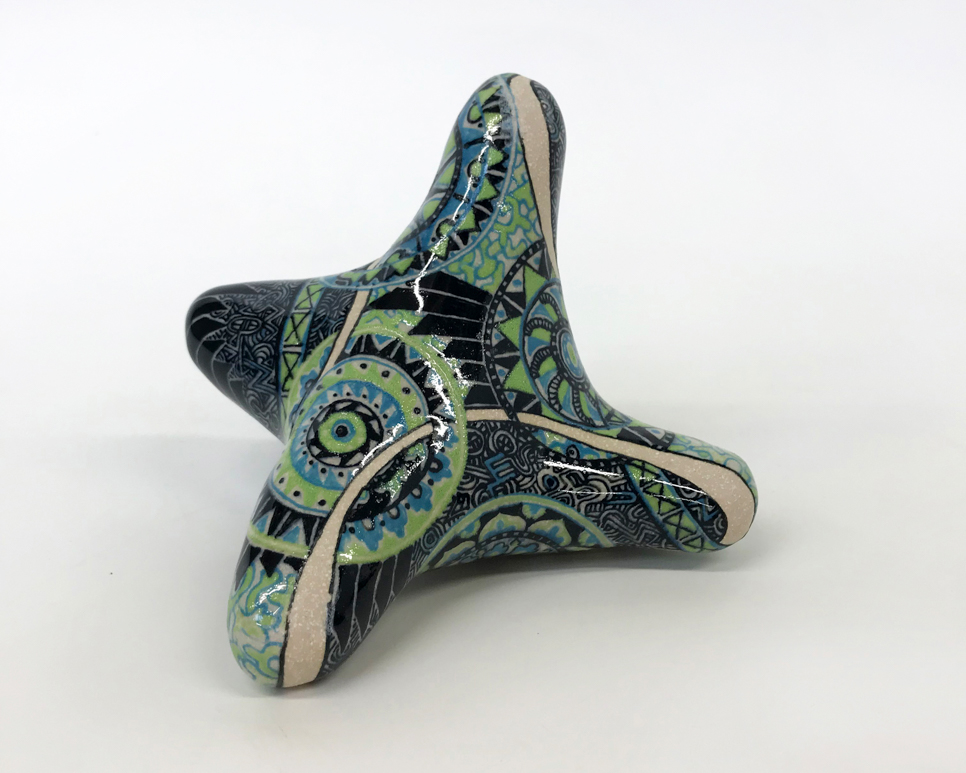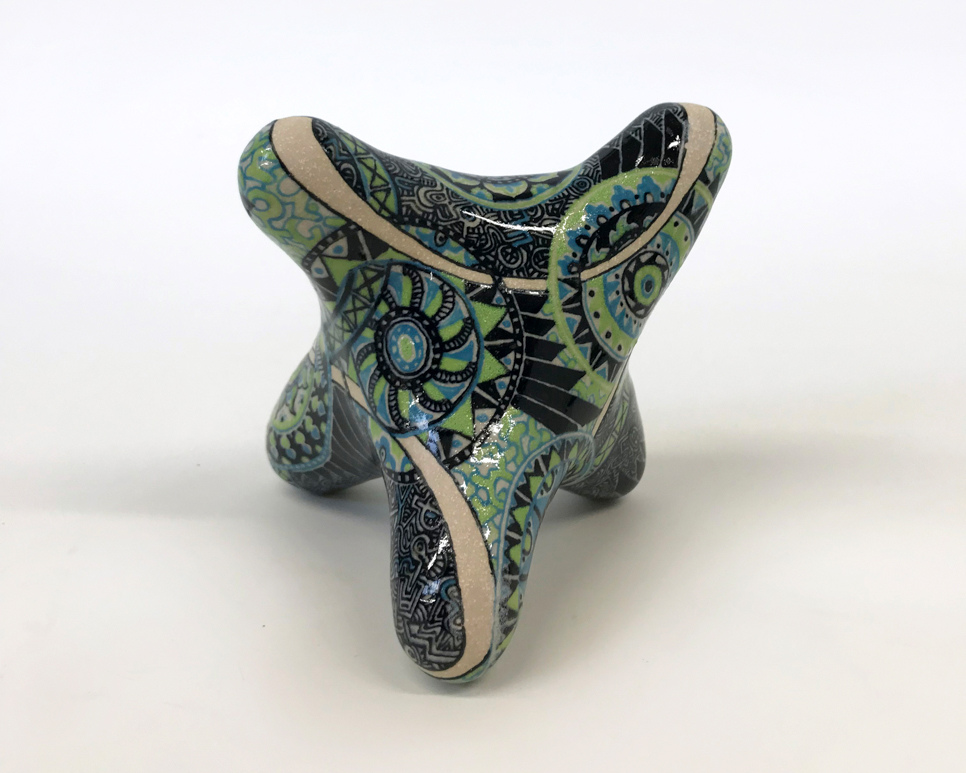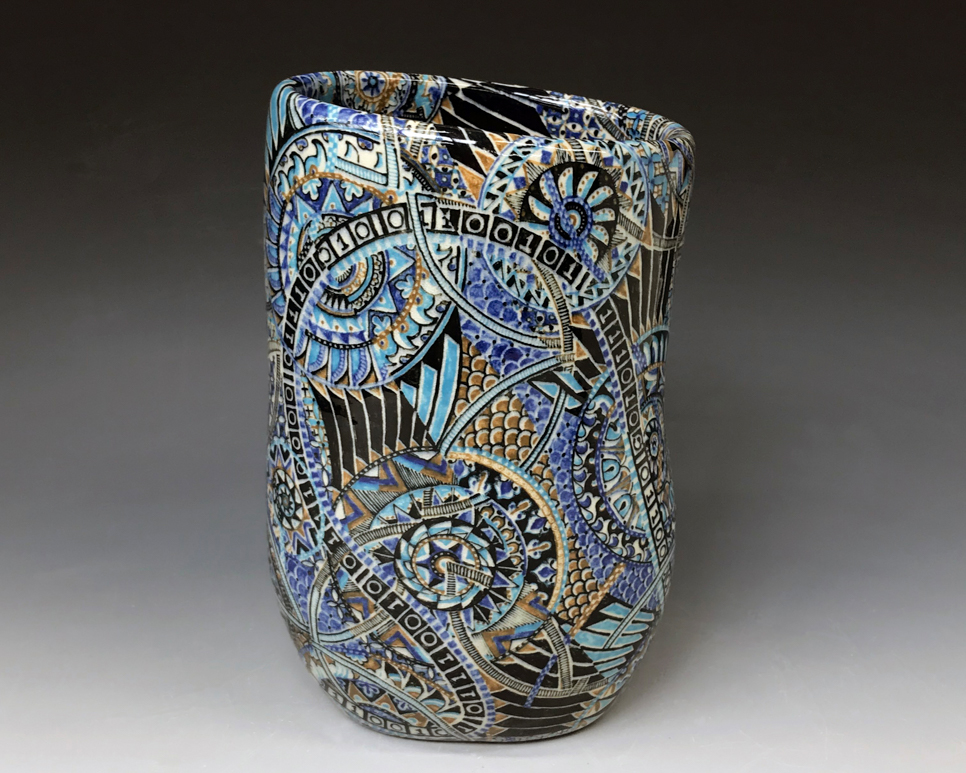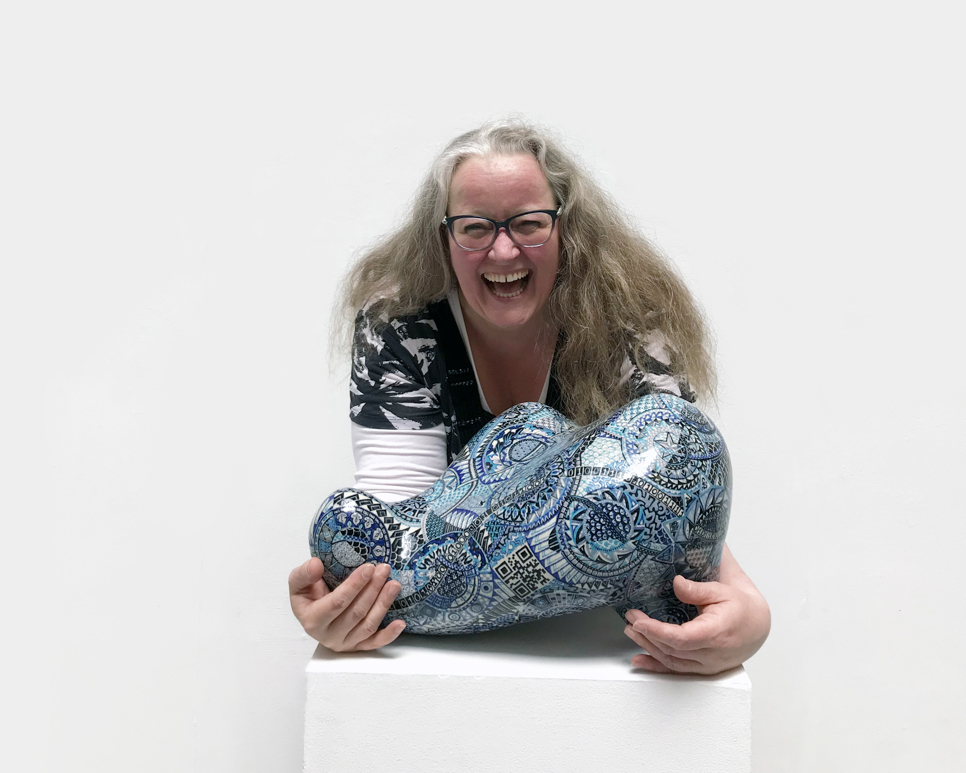Mayco: Can you tell us a little bit about yourself?
Micaela: I am still early on in my career as a ceramic maker. From early childhood I always drew and painted but as late developer or second career maker I am I didn’t study art but I studied Literature instead. This brought me at the age of twenty-six from Germany, where I grew up, to the UK where I finished my studies. I have been living in England since the 1990s, married an English man and worked for a number of years in book publishing before becoming a full time mother. While working and raising our daughter I accumulated more than ten years experience of pottery by attending weekly evening classes. When my daughter left primary/infant school three years ago I decided to go back to university and study ceramics and was fortunate that I was accepted onto the Masters degree course in Ceramics in my hometown at the University of Central Lancashire in Preston.
My personal origins are really important to my work. I grew up bilingually and lived in different countries including Germany, South Africa, the UK and the USA. My family is artistic and I was raised with a strong appreciation of the visual arts especially of African and Scandinavian origins. My sense of self is marked by a lack of belonging that translates into defining myself as a world citizen. Thus, issues of identity and belonging are central to my ceramic work.
What drew you towards working with ceramics?
The first time I got my hands onto clay was during a school exchange program where I spent my junior year at an American high school in a small town not far from Salt Lake City, Utah. They had the most fabulous ceramics studio and a teacher, Mr Brown, who was really happy to teach an interested student. Up until then I hadn’t realize that pottery was something that people could actually DO.
However, once I returned home I couldn’t pursue this any further as my German high school in Hamburg had no ceramic facilities. I only returned to ceramics years later while working in an office in London. I was looking for a creative outlet and remembered my early pottery experience and signed up for an adult evening class at Morley College. I soon found that working with clay was the ideal thing to do after a busy day at work. It is so versatile and with its many different production processes I could fit it easily around whatever mood I was in. The tactile nature of clay and ceramic making is really therapeutic and I loved being a maker. Being able to produce a beautiful and sometimes useful object with my own hands is hugely satisfying and was the perfect antidote to office life.
How would you define the style of your work and how did it develop?
I describe my style as sensuous ceramics with strong elaborate surface pattern decorations. From early childhood on I spent hours drawing and doodling patterns. I enjoy creating a visual harmony but also playing with contrasts and the relationship between foreground and background. During my degree I found a way to combine my love of pattern making with ceramics.
My work divides into two areas: sculptural work, which for me is my main area of interest, and an accompanying range of more functional domestic ware. These functional pottery pieces often function as tests where I try out new ideas and techniques to use on my sculptures. All my ceramics distinguish themselves by their dense surface pattern designs.
The feel of my ceramics is another element that links my different ceramics ranges. My pieces are heavy. I like their heftiness. My sculptures have rounded biomorphic shapes, which are echoed in the rounded rims of my domestic ware. My beakers, platters and vases – just like my sculptures – are often decorated all over, even underneath, and as such I regard them as ‘domestic sculptures’. The overall tactile appeal to me is nearly as important as their visual qualities whether through their overall form or their surfaces.
Can you briefly describe your production process?
Even though I sometimes wheel throw I am mainly a hand-builder and particularly enjoy coiling. Firstly, I choose the clay to pair with the surface treatment I’ll be using. I currently use six different clay bodies, which I combine with as many different surface pattern techniques. However, the basic coiling process remains the same regardless of the final finish: I start off by deciding how many limbs my sculptures will have and mark out an outline onto a piece of paper. I coil the first half of my figures following this outline. Once this has hardened up I flip this half of the figure up-side-down while supporting its shape with foam and bubble wrap before coiling the second half onto it. Depending on how large the figure is this may take a week or two including drying times. Only once it is firmed up enough to remove all the supporting foam and bubble wrap can I see its final shape. Next I spend quite a long time refining it through hours of paddling, scraping, smoothing and refining its surface.
Then my making process may vary depending on what ceramic tradition I’m referencing. For example, for English slipware I would now be applying coloured slips before letting the piece dry out too much. For another range I will water-etch my surface patterns when the piece is bone dry. Generally I pay a lot of attention to how I dry my pieces and this may take between 2-4 weeks.
My range using Mayco Designer Liners get have an extra bisque firing to fix the decorations before glazing. Another range, my Oribe based one, will involve a much looser application of underglazes painted on top of the glazes. My glazes and firings range from low fired traditional lead glazes and high fired glazes in an electric kiln to firing unglazed pieces at cone 10 in reduction in a gas kiln.
How do Mayco glazes and products fit into your work?
The range in which I use Mayco Designer Liners is one of my main lines of production. The Designer Liners are an essential tool for me to apply very colourful and intricately detailed patterns to my ceramics. The colours are really strong and saturated and even the reds and oranges keep their brilliance at quite high firing temperatures. I particularly like the black, which on certain clays gives me strong graphic lines and on others, such as porcelain, melts slightly with a beautiful bluish tint. For me it is very important that the colours don’t come off when touched during the decorating process. I need to be able to handle and rest some of my large pieces on my lap while applying my patterns as they are covered all over, top and bottom. The Mayco Designer Liners are ideal for this. As I spend hours decorating, I make sure to fix the Designer Liner patterns by putting my pieces through a second bisque firing before applying a clear glaze and fire them to high stoneware temperature (ca. 1280°c or cone 9) in an electric kiln.
Is there a universal concept or theme that you would like to retain as the foundation to all your future work?
My work is all about patterns and how they can convey and question meanings. Patterns often convey meaning in pictorial form and can be a means of communication often just a short step away from pictograms or other forms of written communication.
Other artists often take inspiration from nature, I don’t. My inspiration comes from people and what makes them tick and this is often expressed in patterns used to adorn items like pottery and textiles. I am intrigued by the difference and similarities between people, their different views of the world and what motivates their actions. I want to examine the grey areas where ideas cross overs and intermix. A basic interest in humanity and how people expresses themself is the foundation of my work.
The details and designs of your pieces are one of a kind—how did you develop your own and how does it change with time?
Before doing my MA my work was lacking focus. I hadn’t found my direction and had tried everything from handbuilding masks in paper clay, making plaques, throwing bowls and mugs to slipcasting dishes and vases. What linked all of these different exploits was the decorative surface treatments.
During my MA I started researching patterns produced by people from different cultures around the world. I concentrated on patterns found on Acoma Pueblo pottery and Iznik ceramics from the Ottoman Empire, Geometric Islamic patternwork used in architecture and patterns found on African textiles such as Kuba cloth, Adinkra textiles and bark cloth by the M’Buti people. My most recent research extends into pictorial forms of international communications, which include Morse code, braille, alchemical symbolism, international warning signs, binary code and bar codes.
Parallel to that I researched different historical pottery traditions such as Persian ceramics, black-on-black ware by Pueblo potter Maria Martinez, Chinese Celadonware, English lead glazed slipware and Roman Samianware.
I want to combine different pattern elements and pottery traditions to see how they sit alongside each other to ask myself questions such as: Does one pattern/tradition dominate the other? Do they hold their cultural visual identity? When mixed is a new cultural reference made? I am interested in exploring the grey areas, the ones that are not clearly defined.
Using signs and symbols has opened up new exciting possibilities. While seemingly producing very ‘decorative’ pieces they can have many hidden layers and I enjoy using words as part of my work which, if written in Morse code or binary, are more difficult to decipher. So, my ceramics on first glance may look purely decorative but now they hide meanings within.
Can you tell us a little about your studio space? How important is this environment in the conceptualization in your work?
Up until recently I have been using the studio space at university. For three and a half years I was a member of an open access scheme that gives local artist the opportunity one evening a week to use these facilities. Then I spent another two years there as part of my Masters degree followed by another year at this studio when I was awarded a Fellowship at the university after completion of my degree.
In July 2019 a new community pottery, Make North in Preston, with artists’ studio spaces opened in the city I live in and I am one of the artists in residence there, who exchanges teaching for studio space
I really like working within a busy studio environment along with other ceramic artists. The exchange of ideas, camaraderie and support is vital to keep me motivated. Having people see my work in progress and commenting has often led to new ideas and avenues to explore. However, I also enjoy spending long periods of time at home when decorating my pieces, especially when using the Mayco Designer Liners, as they are so clean I can use them in our living room.
What have been the most influential and career changing experiences you have had? What about these experiences was so important?
Going back to university in my late 40’s to complete a Masters Degree in Ceramics at the University of Central Lancashire in Preston, UK, was the most formative and influential experience. It made me focus and home in on what sort of work I wanted to do. This course is a part-time course but I treated it as full-time course to maximize what I could learn during that time while having great tutors and co-students to learn from and having access to facilities that enabled me a much wider range of experimentation. I left the course not only with a much better technical understanding of ceramics but, more importantly, with a clear vision of what my own ceramic work was about while leaving lots of scope for further future development.
Can you tell us about any future projects?
I am in the middle of making my most ambitious piece to date. My largest hand-built figure has come out of the bisque kiln without any cracks and I am now planning the surface decorations. It will take at least a month to decorate it. If this survives the subsequent firings I am tempted to build even larger pieces. I also want to look at the possibilities of incorporating elements of monoprinting into my repertoire of surface treatments. I can see this potentially saving me some time on decorating while introducing a different quality of decoration which I will combine with my other techniques.
I keep applying to selected ceramic shows and residencies. I am selective of which shows to apply for as my work sits closer to fine art than domestic pottery. Luckily there are increasingly more opportunities opening up for high-end ceramics to be shown and sold. Ceramics seems to be having a recent resurgence and gaining acceptance as not just a craft but also an artform. My next show will be the York Ceramics Fair in late November for which I’ll be completing some smaller pieces. For next year application deadlines are coming up soon and I’ll be applying for some UK fairs such as Earth and Fire in Welbeck and Art in Clay in Hatfield while keeping an eye open for other opportunities.
What’s on your mind when you are working?
What I’m thinking of varies a lot depending on whether I’m working in a busy studio or alone at home.
Often I think about the decorative pattern work I’m applying. I don’t plan my patterns in huge detail before starting to apply them. I just have a basic idea of which pattern elements I will combine. I briefly sketch out few lines indicating the general flow lines that underpin the design before placing the circles of my design. From there on I start decorating and spend a lot of time looking at what I’ve done and visualizing my next steps of how to respond with new pattern elements.
That said, sometimes spending too much time in solitude decorating a piece can lead me into not very helpful solipsistic introverted introspections. In that case, I’ll either put on some moderately boring television (not too interesting as I need to keep my eyes on the piece and not the screen) or a good podcast or radio play. It is all about keeping a healthy balance.

